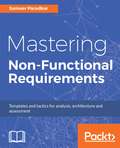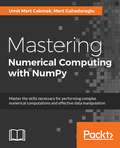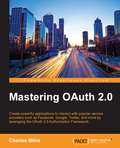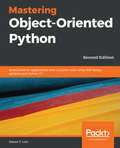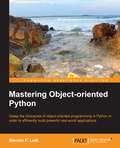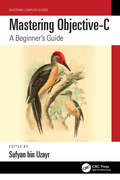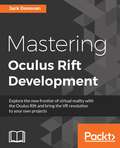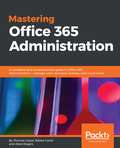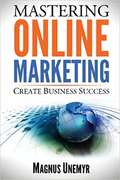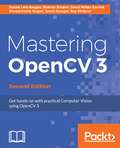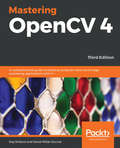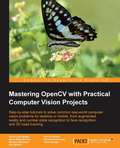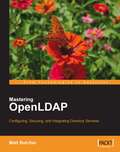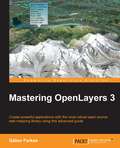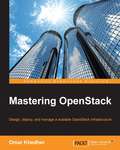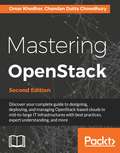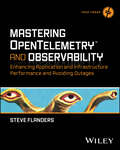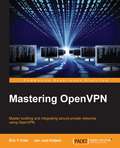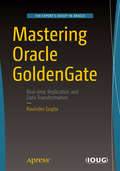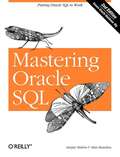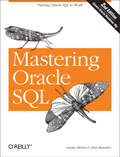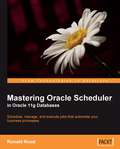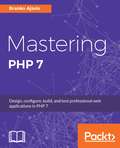- Table View
- List View
Mastering Node.js: Build Robust And Scalable Real-time Server-side Web Applications Efficiently
by Sandro PasqualiNode.js with its strong features and ability to write server as well as client side code with JavaScript has become a popular choice amongst developers for building powerful web applications. This book is a deep dive into showing facets of Node which are helpful for creating highly concurrent and scalable real time applications.
Mastering Non-Functional Requirements
by Sameer ParadkarThis book covers the most critical 24 NFRs that are applicable to IT applications and systems. About This Book • Explains three stages of nonfunctional requirements, that is, analysis, architecture, and assessment • In-depth knowledge of NFR framework and taxonomy that provides guidance around the modelling phase for the NFRs • Coverage of 24 critical and pivotal NFRs, including the analysis, architecture, and assessment. Who This Book Is For The primary audience for this title are the gamut of roles starting from IT consultant to chief architects who are responsible to deliver strategic, tactical, and operational engagements for fortune 100 customers worldwide. Nonfunctional requirements are the key to any software / IT program. They cannot be overlooked or ignored. The book provides a comprehensive approach from analysis, architecture, and measurement of nonfunctional requirements. The book includes considerations for bespoke (Java, .Net, and COTS applications). These are applicable to IT applications from various domains. The book outlines the methodology for capturing the NFRs and also describes a framework that can be leveraged by analysts and architects for tackling NFRs for various engagements. The audience for this book include business analysts, enterprise architects, business architects, solution architects, technical architects/designers, domain/security/integration architects, software developers, support engineers and test engineers, technical project managers, project leads/technical leads/technical project managers, and students from the computer science/IT stream What You Will Learn • Learn techniques related to the analysis, architecture, and monitoring of NFRs • Understand the various tools, techniques, and processes in order to improve the overall quality of the desired outcomes • Embrace the best practices of architecting, metrics, and success factors for NFRs • Identify the common pitfalls to be avoided and the patterns to leverage • Understand taxonomy and framework for NFRs • Learn the design guidelines for architecting applications and systems relating to NFRs • Abstract different methodologies to analyze and gather NFRs In Detail Non-functional Requirements are key to any software/IT program and cannot be overlooked or ignored. This book provides a comprehensive approach to the analysis, architecture, and measurement of NFRs. It includes considerations for bespoke Java, .NET, and COTS applications that are applicable to IT applications/systems in different domains. The book outlines the methodology for capturing the NFRs and also describes a framework that can be leveraged by analysts and architects for tackling NFRs for various engagements. This book starts off by explaining the various KPIs, taxonomies, and methods for identifying NFRs. Learn the design guidelines for architecting applications and systems relating to NFRs and design principles to achieve the desired outcome. We will then move on to various key tiers/layers and patterns pertaining to the business, database, and integrating tiers. After this, we will dive deep into the topics pertaining to techniques related to monitoring and measurement of NFRs, such as sizing, analytical modeling, and quality assurance. Lastly, we end the book by describing some pivotal NFRs and checklists for the software quality attributes related to the business, application, data, and infrastructure domains. Style and approach The book takes a pragmatic approach, describing various techniques related to the analysis of NFRs, the architecture of NFRs, and assessment of NFRs.
Mastering Numerical Computing with NumPy: Master scientific computing and perform complex operations with ease
by Umit Mert Cakmak Mert CuhadarogluEnhance the power of NumPy and start boosting your scientific computing capabilitiesKey FeaturesGrasp all aspects of numerical computing and understand NumPyExplore examples to learn exploratory data analysis (EDA), regression, and clusteringAccess NumPy libraries and use performance benchmarking to select the right toolBook DescriptionNumPy is one of the most important scientific computing libraries available for Python. Mastering Numerical Computing with NumPy teaches you how to achieve expert level competency to perform complex operations, with in-depth coverage of advanced concepts.Beginning with NumPy's arrays and functions, you will familiarize yourself with linear algebra concepts to perform vector and matrix math operations. You will thoroughly understand and practice data processing, exploratory data analysis (EDA), and predictive modeling. You will then move on to working on practical examples which will teach you how to use NumPy statistics in order to explore US housing data and develop a predictive model using simple and multiple linear regression techniques. Once you have got to grips with the basics, you will explore unsupervised learning and clustering algorithms, followed by understanding how to write better NumPy code while keeping advanced considerations in mind. The book also demonstrates the use of different high-performance numerical computing libraries and their relationship with NumPy. You will study how to benchmark the performance of different configurations and choose the best for your system.By the end of this book, you will have become an expert in handling and performing complex data manipulations.What you will learn Perform vector and matrix operations using NumPy Perform exploratory data analysis (EDA) on US housing data Develop a predictive model using simple and multiple linear regression Understand unsupervised learning and clustering algorithms with practical use cases Write better NumPy code and implement the algorithms from scratch Perform benchmark tests to choose the best configuration for your systemWho this book is forMastering Numerical Computing with NumPy is for you if you are a Python programmer, data analyst, data engineer, or a data science enthusiast, who wants to master the intricacies of NumPy and build solutions for your numeric and scientific computational problems. You are expected to have familiarity with mathematics to get the most out of this book.
Mastering OAuth 2.0
by Charles BihisCreate powerful applications to interact with popular service providers such as Facebook, Google, Twitter, and more by leveraging the OAuth 2.0 Authorization FrameworkAbout This BookLearn how to use the OAuth 2.0 protocol to interact with the world's most popular service providers, such as Facebook, Google, Instagram, Slack, Box, and moreMaster the finer details of this complex protocol to maximize the potential of your application while maintaining the utmost of securityStep through the construction of a real-world working application that logs you in with your Facebook account to create a compelling infographic about the most important person in the world--you!Who This Book Is ForIf you are an application developer, software architect, security engineer, or even a casual programmer looking to leverage the power of OAuth, Mastering OAuth 2.0 is for you. Covering basic topics such as registering your application and choosing an appropriate workflow, to advanced topics such as security considerations and extensions to the specification, this book has something for everyone. A basic knowledge of programming and OAuth is recommended.What You Will LearnDiscover the power and prevalence of OAuth 2.0 and use it to improve your application's capabilitiesStep through the process of creating a real-world application that interacts with Facebook using OAuth 2.0Examine the various workflows described by the specification, looking at what they are and when to use themLearn about the many security considerations involved with creating an application that interacts with other service providersDevelop your debugging skills with dedicated pages for tooling and troubleshootingBuild your own rich, powerful applications by leveraging world-class technologies from companies around the worldIn DetailOAuth 2.0 is a powerful authentication and authorization framework that has been adopted as a standard in the technical community. Proper use of this protocol will enable your application to interact with the world's most popular service providers, allowing you to leverage their world-class technologies in your own application. Want to log your user in to your application with their Facebook account? Want to display an interactive Google Map in your application? How about posting an update to your user's LinkedIn feed? This is all achievable through the power of OAuth.With a focus on practicality and security, this book takes a detailed and hands-on approach to explaining the protocol, highlighting important pieces of information along the way.At the beginning, you will learn what OAuth is, how it works at a high level, and the steps involved in creating an application. After obtaining an overview of OAuth, you will move on to the second part of the book where you will learn the need for and importance of registering your application and types of supported workflows. You will discover more about the access token, how you can use it with your application, and how to refresh it after expiration.By the end of the book, you will know how to make your application architecture robust. You will explore the security considerations and effective methods to debug your applications using appropriate tools. You will also have a look at special considerations to integrate with OAuth service providers via native mobile applications. In addition, you will also come across support resources for OAuth and credentials grant.Style and approachWith a focus on practicality and security, Mastering OAuth 2.0 takes a top-down approach at exploring the protocol. Discussed first at a high level, examining the importance and overall structure of the protocol, the book then dives into each subject, adding more depth as we proceed. This all culminates in an example application that will be built, step by step, using the valuable and practical knowledge you have gained.
Mastering Object-Oriented Python: Build powerful applications with reusable code using OOP design patterns and Python 3.7, 2nd Edition
by Steven F. LottGain comprehensive insights into programming practices, and code portability and reuse to build flexible and maintainable apps using object-oriented principlesKey FeaturesExtend core OOP techniques to increase integration of classes created with PythonExplore various Python libraries for handling persistence and object serializationLearn alternative approaches for solving programming problems, with different attributes to address your problem domainBook DescriptionObject-oriented programming (OOP) is a relatively complex discipline to master, and it can be difficult to see how general principles apply to each language's unique features. With the help of the latest edition of Mastering Objected-Oriented Python, you'll be shown how to effectively implement OOP in Python, and even explore Python 3.x. Complete with practical examples, the book guides you through the advanced concepts of OOP in Python, and demonstrates how you can apply them to solve complex problems in OOP. You will learn how to create high-quality Python programs by exploring design alternatives and determining which design offers the best performance. Next, you'll work through special methods for handling simple object conversions and also learn about hashing and comparison of objects. As you cover later chapters, you'll discover how essential it is to locate the best algorithms and optimal data structures for developing robust solutions to programming problems with minimal computer processing. Finally, the book will assist you in leveraging various Python features by implementing object-oriented designs in your programs.By the end of this book, you will have learned a number of alternate approaches with different attributes to confidently solve programming problems in Python.What you will learnExplore a variety of different design patterns for the __init__() methodLearn to use Flask to build a RESTful web serviceDiscover SOLID design patterns and principlesUse the features of Python 3's abstract baseCreate classes for your own applicationsDesign testable code using pytest and fixturesUnderstand how to design context managers that leverage the 'with' statementCreate a new type of collection using standard library and design techniquesDevelop new number types above and beyond the built-in classes of numbersWho this book is forThis book is for developers who want to use Python to create efficient programs. A good understanding of Python programming is required to make the most out of this book. Knowledge of concepts related to object-oriented design patterns will also be useful.
Mastering Object-oriented Python
by Steven F. LottThis book follows a standard tutorial approach with approximately 750 code samples spread through the 19 chapters. This amounts to over 5,900 lines of code that illustrate each concept. This book is aimed at programmers who have already learned the basics of object-oriented Python and need to write more sophisticated, flexible code that integrates seamlessly with the rest of Python. This book assumes a computer science background, with experience of common Python design patterns.
Mastering Objective-C: A Beginner's Guide (Mastering Computer Science)
by Sufyan Bin UzayrMastering Objective-C is a detailed guide for beginners that gives a modern programmer’s viewpoint on Objective-C. It introduces the principles of Objective-C and current Apple programming skills and libraries allowing the reader to make the best use of the tools available. Concise and easy to understand, this book covers many topics including, an introduction to key concepts of language and primary toolkits, as well as the Foundation and AppKit frameworks to help quickly advance with the necessary information. This book explains how to structure applications properly and organize code for optimum performance. The fundamental principles explained here are helpful to beginner and intermediate users interested in learning this highly technological and diverse language.
Mastering Oculus Rift Development
by Jack DonovanExplore the new frontier of virtual reality with the Oculus Rift and bring the VR revolution to your own projects About This Book • Create immersive 3D games especially designed for the Oculus Rift platform • Build complex realistic virtual reality (VR) games with the Unity Engine • Create striking VR environments with advanced graphical techniques Who This Book Is For This book is for aspiring indie developers and VR enthusiasts who want to bring their ideas into virtual reality with a new platform that provides an unprecedented level of realism and immersion. What You Will Learn • Increase immersion with 3D audio and intuitive interfaces • Create group VR experiences using multi-player networking • Design fun and engaging mechanics that utilize VR principles • Explore the best ways to navigate and interact using the Oculus Rift • Design intuitive ways to navigate and interact with scenes in VR • Add stunning realism to a scene with three-dimensional audio • Invent mechanics and features that take full advantage of VR hardware In Detail Virtual reality (VR) is changing the world of gaming and entertainment as we know it. VR headsets such as the Oculus Rift immerse players in a virtual world by tracking their head movements and simulating depth, giving them the feeling that they are actually present in the environment. We will first use the Oculus SDK in the book and will then move on to the widely popular Unity Engine, showing you how you can add that extra edge to your VR games using the power of Unity. In this book, you'll learn how to take advantage of this new medium by designing around each of its unique features. This book will demonstrate the Unity 5 game engine, one of most widely-used engines for VR development, and will take you through a comprehensive project that covers everything necessary to create and publish a complete VR experience for the Oculus Rift. You will also be able to identify the common perils and pitfalls of VR development to ensure that your audience has the most comfortable experience possible. By the end of the book, you will be able to create an advanced VR game for the Oculus Rift, and you'll have everything you need to bring your ideas into a new reality. Style and approach This book takes a step-by-step tutorial approach with illustrative examples to help you implement the projects on your own. The book lets you first get to grips with the Oculus SDK and then moves on to the Unity Engine to add realistic graphics and features in your games.
Mastering Office 365 Administration: A complete and comprehensive guide to Office 365 Administration - manage users, domains, licenses, and much more
by Thomas Carpe Alara Rogers Nikkia CarterLeverage Office 365 to increase your organization's efficiencyKey FeaturesPerform common to advanced-level management and administrative tasks for your organization with Office 365 Become an Office 365 generalist who can work with the entire stack—not just specific productsAn advanced-level guide that will teach you to implement enterprise-level services into your organization, no matter the size of the businessBook DescriptionIn today's world, every organization aims to migrate to the cloud in order to become more efficient by making full use of the latest technologies. Office 365 is your one-stop solution to making your organization reliable, scalable, and fast.This book will start with an overview of Office 365 components, and help you learn how to use the administration portal, and perform basic administration. It then goes on to cover common management tasks, such as managing users, admin roles, groups, securing Office 365, and enforcing compliance. In the next set of chapters, you will learn about topics including managing Skype for Business Online, Yammer, OneDrive for Business, and Microsoft Teams. In the final section of the book, you will learn how to carry out reporting and monitor Office 365 service health.By the end of this book, you will be able to implement enterprise-level services with Office 365 based on your organization's needs.What you will learn Understand the vast Office 365 feature set Understand how workloads and applications interact and integrate with each other Connect PowerShell to various Office 365 services and perform tasks Manage Skype for Business Online Get support and monitor Office 365 service health Manage and administer identities and groups efficientlyWho this book is forThis book targets architects, sys admins, engineers, and administrators who are working with Office 365 and are responsible for configuring, implementing, and managing Office 365 in their organization. A prior knowledge of Office 365 and Exchange servers is mandatory.
Mastering Online Marketing: Create business success through content marketing, lead generation, and marketing automation
by Magnus Unemyr<p>Mastering Online Marketing is the most comprehensive and up-to-date book available on advanced web marketing. It reveals the secrets that can help take your Internet marketing to a new level. <p>Hundreds of books have been published on online marketing, so what makes this one special? Whether you are new to the subject and looking for a comprehensive overview, or are familiar with the concepts but want to get more from your marketing efforts, with this book, you will learn state-of-the-art techniques and get actionable and practical knowledge to set up an efficient online marketing system to support and improve your business. <p>This book describes the latest developments in Internet marketing and provides detailed and practical knowledge that can help you improve your campaigns to get more visitors, leads, and customers. By using these tools and techniques, you can quickly outperform your competition. <p>Mastering Online Marketing will turn you into an online marketing expert and teach you everything you need to know.</p>
Mastering OpenCV 3 - Second Edition
by Shervin Emami Daniel Lélis BaggioThis book is for those who have a basic knowledge of OpenCV and are competent C++ programmers. You need to have an understanding of some of the more theoretical/mathematical concepts, as we move quite quickly throughout the book.
Mastering OpenCV 4 - Third Edition: A comprehensive guide to building computer vision and image processing applications with C++, 3rd Edition
by David Millan Escriva Roy ShilkrotThis book is for computer vision engineers looking to get grips with OpenCV, mostly in a C++ environment, with a hands-on approach rather than the traditional ground-up knowledge construction. The book provides concrete example usage of the OpenCV API toward common computer vision tasks. You are expected to have a firm grasp of programming concepts and software engineering skills, and be able to build and run software in C++ from scratch.
Mastering OpenCV 4 with Python: A practical guide covering topics from image processing, augmented reality to deep learning with OpenCV 4 and Python 3.7
by Alberto Fernandez VillanCreate advanced applications with Python and OpenCV, exploring the potential of facial recognition, machine learning, deep learning, web computing and augmented reality. Key Features Develop your computer vision skills by mastering algorithms in Open Source Computer Vision 4 (OpenCV 4)and Python Apply machine learning and deep learning techniques with TensorFlow, Keras, and PyTorch Discover the modern design patterns you should avoid when developing efficient computer vision applications Book Description OpenCV is considered to be one of the best open source computer vision and machine learning software libraries. It helps developers build complete projects in relation to image processing, motion detection, or image segmentation, among many others. OpenCV for Python enables you to run computer vision algorithms smoothly in real time, combining the best of the OpenCV C++ API and the Python language. In this book, you'll get started by setting up OpenCV and delving into the key concepts of computer vision. You'll then proceed to study more advanced concepts and discover the full potential of OpenCV. The book will also introduce you to the creation of advanced applications using Python and OpenCV, enabling you to develop applications that include facial recognition, target tracking, or augmented reality. Next, you'll learn machine learning techniques and concepts, understand how to apply them in real-world examples, and also explore their benefits, including real-time data production and faster data processing. You'll also discover how to translate the functionality provided by OpenCV into optimized application code projects using Python bindings. Toward the concluding chapters, you'll explore the application of artificial intelligence and deep learning techniques using the popular Python libraries TensorFlow, and Keras. By the end of this book, you'll be able to develop advanced computer vision applications to meet your customers' demands. What you will learn Handle files and images, and explore various image processing techniques Explore image transformations, including translation, resizing, and cropping Gain insights into building histograms Brush up on contour detection, filtering, and drawing Work with Augmented Reality to build marker-based and markerless applications Work with the main machine learning algorithms in OpenCV Explore the deep learning Python libraries and OpenCV deep learning capabilities Create computer vision and deep learning web applications Who this book is for This book is designed for computer vision developers, engineers, and researchers who want to develop modern computer vision applications. Basic experience of OpenCV and Python programming is a must.
Mastering OpenCV with Practical Computer Vision Projects
by Khvedchenia Levgen Naureen Mahmood Shervin EmamiEach chapter in the book is an individual project and each project is constructed with step-by-step instructions, clearly explained code, and includes the necessary screenshots. You should have basic OpenCV and C/C++ programming experience before reading this book, as it is aimed at Computer Science graduates, researchers, and computer vision experts widening their expertise.
Mastering OpenLDAP: Configuring, Securing and Integrating Directory Services
by Matt ButcherThis book has been written from the application developer's perspective, tackling the topics that will be most important to helping the application developer understand OpenLDAP, and get it set up as securely and quickly as possible. It shows how OpenLDAP interoperates with other UNIX/Linux services (DNS, NIS, Samba, etc.). The target audience will require basic Linux system administration knowledge, but no prior knowledge of LDAP or OpenLDAP is assumed. If you are web savvy and are interested in using OpenLDAP for web applications and services like client interaction then this is the book for you.
Mastering OpenLayers 3
by Gabor FarkasCreate powerful applications with the most robust open source web mapping library using this advanced guide About This Book * Develop responsive and platform-independent web mapping applications with OpenLayers 3 * Learn the key points of creating great applications with native JavaScript through the step-by-step examples * Master the use of the library, from compiling custom builds to developing a complete WebGIS application Who This Book Is For This book is intended for front-end developers with basic understanding of JavaScript and GIS concepts, and preferably for those who are familiar with the fundamentals of OpenLayers 3. You might have never used OpenLayers 3 as a seasoned JavaScript developer. If this is the case and you are eager to learn web mapping, this book will definitely set you on the right track. What You Will Learn * Use the advanced functionality of the OpenLayers 3 library effectively * Implement the library in your application, shaping it to your needs * Manage layers and the layer stack dynamically * Create not only stunning but also accurate thematic maps * Extend OpenLayers 3 with your own custom classes * Develop mobile-friendly web mapping applications * Make stunning effects with canvas manipulation, or visualize point clouds with WebGL * Integrate third-party applications, and create custom builds that completely satisfy your needs In Detail OpenLayers 3 allows you to create stunning web mapping and WebGIS applications. It uses modern, cutting edge browser technologies. It is written with Closure Library, enabling you to build browser-independent applications without painful debugging ceremonies, which even have some limited fallback options for older browsers. With this guide, you will be introduced to the world of advanced web mapping and WebGIS. First, you will be introduced to the advanced features and functionalities available in OpenLayers 3. Next, you will be taken through the key points of creating custom applications with OpenLayers 3. You will then learn how to create the web mapping application of yours (or your company's) dream with this open source, expense-free, yet very powerful library. We'll also show you how to make amazing looking thematic maps and create great effects with canvas manipulation. By the end of this book, you will have a strong command of web mapping and will be well on your way to creating amazing applications using OpenLayers 3. Style and approach This is an advanced guide packed with comprehensive examples, and it concentrates on the advanced parts of OpenLayers 3 and JavaScript. It intentionally skips the basic and well-known methodologies, but discusses the hard-to-understand ones in great detail.
Mastering OpenStack
by Omar Khedher<P><P>Design, deploy, and manage a scalable OpenStack infrastructure <P><P>About This Book <P><P>Learn how to design and deploy an OpenStack private cloud using automation tools and best practices <P><P>Gain valuable insight into OpenStack components and new services <P><P>Explore the opportunities to build a scalable OpenStack infrastructure with this comprehensive guide <P><P>Who This Book Is For <P><P>This book is intended for system administrators, cloud engineers, and system architects who want to deploy a cloud based on OpenStack in a mid- to large-sized IT infrastructure. If you have a fundamental understanding of cloud computing and OpenStack and want to expand your knowledge, then this book is an excellent checkpoint to move forward. <P><P>What You Will Learn <P><P>Explore the main architecture design of OpenStack components, core-by-core services, and how they work together <P><P>Learn how to distribute OpenStack services among cluster setup <P><P>Compare different storage solutions and driver extensions <P><P>Design different high availability scenarios and how to plan for a no Single Point Of Failure environment <P><P>Set up a multinode environment in production using orchestration tools <P><P>Boost OpenStack performance with advanced configuration <P><P>Establish a distributed monitoring solution and keep track of resource consumption <P><P>In Detail <P><P>This comprehensive guide will help you to choose the right practical option and make strategic decisions about the OpenStack cloud environment to fit your infrastructure in production. <P><P>At the start, this book will explain the OpenStack core architecture. You will soon be shown how to create your own OpenStack private cloud. <P><P>Next, you will move on to cover the key security layer and network troubleshooting skills, along with some advanced networking features. Finally, you will gain experience of centralizing and logging OpenStack. The book will show you how to carry out performance tuning based on OpenStack service logs. <P><P>By the end of this book, you will be ready to take steps to deploy and manage an OpenStack cloud with the latest open source technologies.
Mastering OpenStack - Second Edition
by Omar Khedher Chandan Dutta ChowdhuryDiscover your complete guide to designing, deploying, and managing OpenStack-based clouds in mid-to-large IT infrastructures with best practices, expert understanding, and more About This Book • Design and deploy an OpenStack-based cloud in your mid-to-large IT infrastructure using automation tools and best practices • Keep yourself up-to-date with valuable insights into OpenStack components and new services in the latest OpenStack release • Discover how the new features in the latest OpenStack release can help your enterprise and infrastructure Who This Book Is For This book is for system administrators, cloud engineers, and system architects who would like to deploy an OpenStack-based cloud in a mid-to-large IT infrastructure. This book requires a moderate level of system administration and familiarity with cloud concepts. What You Will Learn • Explore the main architecture design of OpenStack components and core-by-core services, and how they work together • Design different high availability scenarios and plan for a no-single-point-of-failure environment • Set up a multinode environment in production using orchestration tools • Boost OpenStack's performance with advanced configuration • Delve into various hypervisors and container technology supported by OpenStack • Get familiar with deployment methods and discover use cases in a real production environment • Adopt the DevOps style of automation while deploying and operating in an OpenStack environment • Monitor the cloud infrastructure and make decisions on maintenance and performance improvement In Detail In this second edition, you will get to grips with the latest features of OpenStack. Starting with an overview of the OpenStack architecture, you'll see how to adopt the DevOps style of automation while deploying and operating in an OpenStack environment. We'll show you how to create your own OpenStack private cloud. Then you'll learn about various hypervisors and container technology supported by OpenStack. You'll get an understanding about the segregation of compute nodes based on reliability and availability needs. We'll cover various storage types in OpenStack and advanced networking aspects such as SDN and NFV. Next, you'll understand the OpenStack infrastructure from a cloud user point of view. Moving on, you'll develop troubleshooting skills, and get a comprehensive understanding of services such as high availability and failover in OpenStack. Finally, you will gain experience of running a centralized logging server and monitoring OpenStack services. The book will show you how to carry out performance tuning based on OpenStack service logs. You will be able to master OpenStack benchmarking and performance tuning. By the end of the book, you'll be ready to take steps to deploy and manage an OpenStack cloud with the latest open source technologies. Style and approach This book will help you understand the flexibility of OpenStack by showcasing integration of several out-of-the-box solutions in order to build a large-scale cloud environment.. It will also cover detailed discussions on the various design and deployment strategies for implementing a fault-tolerant and highly available cloud infrastructure.
Mastering OpenTelemetry and Observability: Enhancing Application and Infrastructure Performance and Avoiding Outages (Tech Today)
by Steve FlandersDiscover the power of open source observability for your enterprise environment In Mastering Observability and OpenTelemetry: Enhancing Application and Infrastructure Performance and Avoiding Outages, accomplished engineering leader and open source contributor Steve Flanders unlocks the secrets of enterprise application observability with a comprehensive guide to OpenTelemetry (OTel). Explore how OTel transforms observability, providing a robust toolkit for capturing and analyzing telemetry data across your environment. You will learn how OTel delivers unmatched flexibility, extensibility, and vendor neutrality, freeing you from vendor lock-in and enabling data sovereignty and portability. You will also discover: Comprehensive coverage of observability issues and technology: Dive deep into the world of observability and gain a comprehensive understanding of observability fundamentals with practical insights and real-world use cases. Practical guidance: From instrumentation techniques to advanced tracing strategies, gain the skills needed to create highly observable systems. Learn how to deploy and configure OTel, even in challenging brownfield environments, with step-by-step instructions and hands-on exercises. An opportunity for community contributions and communication: Join the OTel community, including end-users, vendors, and cloud providers, and shape the future of observability while connecting with experts and peers. Whether you are a novice or a seasoned professional, Mastering Observability and OpenTelemetry is your roadmap to troubleshooting availability and performance problems by learning to detect anomalies, interpret data, and proactively optimize performance in your enterprise environment. Embark on your journey to observability mastery today!
Mastering OpenVPN
by Jan Just Keijser Eric F CristMaster building and integrating secure private networks using OpenVPN About This Book * Discover how to configure and set up a secure OpenVPN * Enhance user experience by using multiple authentication methods * Delve into better reporting, monitoring, logging, and control with OpenVPN Who This Book Is For If you are familiar with TCP/IP networking and general system administration, then this book is ideal for you. Some knowledge and understanding of core elements and applications related to Virtual Private Networking is assumed. What You Will Learn * Identify different VPN protocols (IPSec, PPTP, OpenVPN) * Build your own PKI and manage certificates * Deploy your VPN on various devices like PCs, mobile phones, tablets, and more * Differentiate between the routed and bridged network * Enhance your VPN with monitoring and logging * Authenticate against third-party databases like LDAP or the Unix password file * Troubleshoot an OpenVPN setup that is not performing correctly In Detail Security on the internet is increasingly vital to both businesses and individuals. Encrypting network traffic using Virtual Private Networks is one method to enhance security. The internet, corporate, and "free internet" networks grow more hostile every day. OpenVPN, the most widely used open source VPN package, allows you to create a secure network across these systems, keeping your private data secure. The main advantage of using OpenVPN is its portability, which allows it to be embedded into several systems. This book is an advanced guide that will help you build secure Virtual Private Networks using OpenVPN. You will begin your journey with an exploration of OpenVPN, while discussing its modes of operation, its clients, its secret keys, and their format types. You will explore PKI: its setting up and working, PAM authentication, and MTU troubleshooting. Next, client-server mode is discussed, the most commonly used deployment model, and you will learn about the two modes of operation using "tun" and "tap" devices. The book then progresses to more advanced concepts, such as deployment scenarios in tun devices which will include integration with back-end authentication, and securing your OpenVPN server using iptables, scripting, plugins, and using OpenVPN on mobile devices and networks. Finally, you will discover the strengths and weaknesses of the current OpenVPN implementation, understand the future directions of OpenVPN, and delve into the troubleshooting techniques for OpenVPN. By the end of the book, you will be able to build secure private networks across the internet and hostile networks with confidence. Style and approach An easy-to-follow yet comprehensive guide to building secure Virtual Private Networks using OpenVPN. A progressively complex VPN design is developed with the help of examples. More advanced topics are covered in each chapter, with subjects grouped according to their complexity, as well as their utility.
Mastering Oracle GoldenGate
by Ravinder GuptaMaster Oracle GoldenGate technology on multiple database platforms using this step-by-step implementation guide. Learn about advanced features to use in building a robust, high-availability replication system. Provided are detailed illustration of Oracle GoldenGate concepts, GoldenGate tools and add-ons, as well as illustrative examples. The book covers Oracle GoldenGate for Oracle database, and also discusses setup and configuration for other common databases such as IBM DB2, SYBASE ASE, MySQL, and Microsoft SQL Server. The technology landscape is fast-changing, and Mastering Oracle GoldenGate stays current by covering the new features included in Oracle GoldenGate 12c. The book covers both classic capture and integrated capture, as well as delivery. Also covered are Oracle GoldenGate security and performance tuning, to keep your system secure and performing at its best. You will learn to monitor your GoldenGate system using tools that come with Oracle GoldenGate management pack, as well as using shell scripts. Troubleshooting is well-illustrated with examples: Covering Oracle GoldenGate technology across common database brands Discussing high-performing and secure replication environments Speaking to replication in Big Data and cloud computing environments What You Will Learn Implement Oracle GoldenGate for real time replication Secure and tune your replication environment for high performance Administer your Oracle GoldenGate environment Learn troubleshooting approaches with help of examples Make use of GoldenGate Management Pack and its API Feed live data into Big Data and cloud-based systems Who This Book Is For Database professionals who have chosen to ride the Oracle GoldenGate roller coaster for real-time replication solutions. The book is for beginners as well as professionals who are willing to master the leading replication technology in the industry. It is an excellent choice for professionals who are implementing or maintaining Oracle GoldenGate replication environments on any of the major database management system platforms.
Mastering Oracle SQL, 2nd Edition
by Sanjay Mishra Alan BeaulieuUpdated to cover Oracle 10g, this new edition of the highly regarded Mastering Oracle SQL has a stronger focus on practical, expert best-practices and on Oracle-specific SQL technique than any other book on the market. For those who want to harness the untapped (and often overlooked) power of Oracle SQL, this essential guide for putting Oracle SQL to work will prove invaluable.
Mastering Oracle SQL: Putting Oracle SQL to Work
by Sanjay Mishra Alan BeaulieuThe vast majority of Oracle SQL books discuss some syntax, provide the barest rudiments of using Oracle SQL, and perhaps include a few simple examples. It might be enough to pass a survey course, or give you some buzz words to drop in conversation with real Oracle DBAs. But if you use Oracle SQL on a regular basis, you want much more. You want to access the full power of SQL to write queries in an Oracle environment. You want a solid understanding of what's possible with Oracle SQL, creative techniques for writing effective and accurate queries, and the practical, hands-on information that leads to true mastery of the language. Simply put, you want useful, expert best practices that can be put to work immediately, not just non-vendor specific overview or theory.Updated to cover the latest version of Oracle, Oracle 10g, this edition of the highly regarded Mastering Oracle SQL has a stronger focus on technique and on Oracle's implementation of SQL than any other book on the market. It covers Oracle s vast library of built-in functions, the full range of Oracle SQL query-writing features, regular expression support, new aggregate and analytic functions, subqueries in the SELECT and WITH clauses, multiset union operators, enhanced support for hierarchical queries: leaf and loop detection, and the CONNECT_BY_ROOT operator, new partitioning methods (some introduced in Oracle9i Release 2), and the native XML datatype, XMLType.Mastering Oracle SQL, 2nd Edition fills the gap between the sometimes spotty vendor documentation, and other books on SQL that just don't explore the full depth of what is possible with Oracle-specific SQL. For those who want to harness the untapped (and often overlooked) power of Oracle SQL, this essential guide for putting Oracle SQL to work will prove invaluable.
Mastering Oracle Scheduler in Oracle 11g Databases
by Ronald RoodThis is your practical guide to setting up a working environment and using Oracle Scheduler. Packed with simple examples and clear explanations, real-life scenarios are discussed to make you comfortable in implementing them in your own system. This book is intended for Administrators and Developers who currently use tools like cron, DBMS_JOB, and the task manager, but who now want more control or who have a need to scale up to tools that can handle the network. Complex tasks can be built that easily control business process and enable the completion of important tasks in limited time. The reader is expected to have some experience of Oracle Database Management, and a working knowledge of SQL and PL/SQL.
Mastering PHP 7
by Branko AjzeleEffective, readable, and robust codes in PHP About This Book • Leverage the newest tools available in PHP 7 to build scalable applications • Embrace serverless architecture and the reactive programming paradigm, which are the latest additions to the PHP ecosystem • Explore dependency injection and implement design patterns to write elegant code Who This Book Is For This book is for intermediate level developers who want to become a master of PHP. Basic knowledge of PHP is required across areas such as basic syntax, types, variables, constants, expressions, operators, control structures, and functions. What You Will Learn • Grasp the current state of PHP language and the PHP standards • Effectively implement logging and error handling during development • Build services through SOAP and REST and Apache Trift • Get to know the benefits of serverless architecture • Understand the basic principles of reactive programming to write asynchronous code • Practically implement several important design patterns • Write efficient code by executing dependency injection • See the working of all magic methods • Handle the command-line area tools and processes • Control the development process with proper debugging and profiling In Detail PHP is a server-side scripting language that is widely used for web development. With this book, you will get a deep understanding of the advanced programming concepts in PHP and how to apply it practically The book starts by unveiling the new features of PHP 7 and walks you through several important standards set by PHP Framework Interop Group (PHP-FIG). You'll see, in detail, the working of all magic methods, and the importance of effective PHP OOP concepts, which will enable you to write effective PHP code. You will find out how to implement design patterns and resolve dependencies to make your code base more elegant and readable. You will also build web services alongside microservices architecture, interact with databases, and work around third-party packages to enrich applications. This book delves into the details of PHP performance optimization. You will learn about serverless architecture and the reactive programming paradigm that found its way in the PHP ecosystem. The book also explores the best ways of testing your code, debugging, tracing, profiling, and deploying your PHP application. By the end of the book, you will be able to create readable, reliable, and robust applications in PHP to meet modern day requirements in the software industry. Style and approach This is a comprehensive, step-by-step practical guide to developing scalable applications using PHP 7.1

